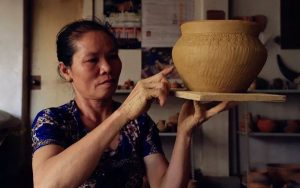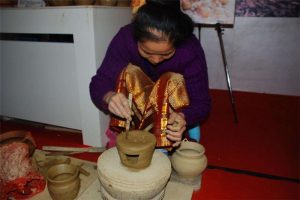 alt="Puer Surrounding Counties and Towns: Weekly & Special Local Markets Travel Guide"
/>
alt="Puer Surrounding Counties and Towns: Weekly & Special Local Markets Travel Guide"
/>
Slow-wheel Pottery Making Skills of Dai Ethnic Minority
Brief Introduction
Dai Ethnic Minority have been fond of pottery since ancient time . Up to now, traditional pottery manufacturing skills have been reserved in many villages of Xishuangbanna Dai Autonomous Prefecture.The slow-wheel pottery manufacturing skills entered the list of national intangible cultural heritages in 2006. Dai people is widely used in daily production, life and Buddhist activities.

Materials And Production Process
Pottery making tools generally consist of wooden pottery pats, pebbles, bamboo slices, boards, wooden hammers and small dustpans with different sizes and patterns. The materials are clay which is abundant everywhere. Generally, it passes through several processes, such as taking soil, drying soil, sieving soil, Gaza and mud, installing turntable, making billet, cooling and drying, firing, etc. Mud and gravel are used in the material, open-air roasting and closed semi-roasting are used, and embryo-forming methods are diversified. The embryo is made by runner, toe-pulling slow wheel, hand-pulling runner, etc. These technological processes fully prove that Dai ceramics preserved the ancient pottery-making technology.
Features of Pottery Making
Pottery making is also called “plate mill” in Dai language , commonly known as “earthen pot”. The main varieties are pots, pots, steamers, pots and so on, among which earthen pots are the most famous. The earthen pot cooked by traditional pottery method is easy to cook and delicious, while the water is refreshing and refreshing. The decoction can maintain the best medicinal properties, and is popular with local people. The craftsmanship is characterized by slow wheel hand craftsmanship, and the surface of the objects is printed with engraved wooden pats, which is very similar to the Neolithic pottery unearthed in the south.

Impart And Inherit
Dai People’s pottery is made by women. In order not to spread its skills, some places still follow the custom of making pottery, which is not passed on to their children, but only to their daughters-in-law. Up to now, archaeologists and ethnologists at home and abroad have investigated this technology. It is generally believed that traditional Dai ceramics have become a breakthrough in understanding Chinese Neolithic ceramics technology and represent the oldest ceramics in China.
Chinese Version: http://www.ynich.cn/view-ml-11110-1252.html
Translated by Winnie Zhang /张赢

 7 Days GolfingTour
7 Days GolfingTour
 8 Days Group Tour
8 Days Group Tour
 8 Days Yunnan Tour
8 Days Yunnan Tour
 7 Days Shangri La Hiking
7 Days Shangri La Hiking
 11 Days Yunnan Tour
11 Days Yunnan Tour
 6 Days Yuanyang Terraces
6 Days Yuanyang Terraces
 11 Days Yunnan Tour
11 Days Yunnan Tour
 8 Days South Yunnan
8 Days South Yunnan
 7 Days Tea Tour
7 Days Tea Tour
 8 Days Muslim Tour
8 Days Muslim Tour
 12 Days Self-Driving
12 Days Self-Driving
 4 Days Haba Climbing
4 Days Haba Climbing
 Tiger Leaping Gorge
Tiger Leaping Gorge
 Stone Forest
Stone Forest
 Yunnan-Tibet
Yunnan-Tibet
 Hani Rice Terraces
Hani Rice Terraces
 Kunming
Kunming
 Lijiang
Lijiang
 Shangri-la
Shangri-la
 Dali
Dali
 XishuangBanna
XishuangBanna
 Honghe
Honghe
 Kunming
Kunming
 Lijiang
Lijiang
 Shangri-la
Shangri-la
 Yuanyang Rice Terraces
Yuanyang Rice Terraces
 Nujiang
Nujiang
 XishuangBanna
XishuangBanna
 Spring City Golf
Spring City Golf
 Snow Mountain Golf
Snow Mountain Golf
 Stone Mountain Golf
Stone Mountain Golf













 What Our Customers Say?
What Our Customers Say?
